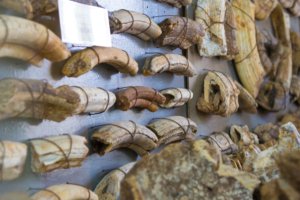There are very few places in Malta that can take you back two million years in the blink of an eye;
one of these places is Ghar Dalam Cave. A naturally formed, Ghar Dalam Cave, holds the remains of
animals that roamed down from Sicily during the dry cycle of the Ice Age, the latter got trapped on
the island once the season changed to wet again. Being stuck here changed these animals
drastically; in a bid to survive small animals started growing larger in a process called Gigantism,
while large animals started shrinking in a process called Dwarfism. Usually huge animals, such as the
elephant and the hippopotamus, began shrinking to adapt to the lower food supply the land they
were now trapped on could supply. On the other hand small animals, like the shrew and the tortoise,
both of whom have multiple offspring, were now growing larger so that they could better compete
for the now less numerous females of the species available on in a much smaller island. These
changes can be seen from the row upon row of bone remains of these animals, many of which are
exhibited in the very Victorian style showcases of the museum built a few metres away from the
cave. Apart from these changes the remains tell a story about the environment present at that time,
not only do we find remains of animals that no longer can be found on the island such as the bear,
dear and the wolf but it is also very clear that Malta was a much greener island with different flora
and fauna and overall landscape. An idea of how the Ghar Dalam Valley might have looked is given
by the huge painting by Adrian Caruana Dingli hanging in the more recent section of the museum.
As if the above was not enough to elevate the importance of Ghar Dalam Cave, it is also one of the sites
that bear evidence of the first human occupations of the island. Like their animal predecessors, they
arrived from Sicily, this time via sea. It is highly likely that Ghar Dalam Cave was used as a settlement
between 5,200 and 4,500 BC. Although one might think of these people as uncivilised brutes their
remains give us a different picture, one of cultured people who could make pottery, some of which
shaped in animal heads, who fashioned stone and bone tools from the raw materials available and
who also kept contact with Sicily, their land of origin, as remains of obsidian (a volcanic rock) prove.
Remains of impressively large fossilised shark teeth also hint at the sort of sea creatures these
islanders may have encountered on their crossings between the islands.

Ice age animals remains
Ghar Dalam Cave will also fascinate those interested in ecology and geological formations. This
water-worn cave has several stalagmites and stalactites which have mesmerised hundreds of young
visitors. The budding archaeologists, or those who have a latent wish for Indiana Jones adventures,
will also be pleased to see Stratigraphic walls, columns, and animal bones still in situ dating back to a
now more than a century old excavation. The museum was opened to the public in 1933 and closed
briefly during the Second World War when it was used as an air raid shelter during World War II and
also as a fuel store by the British Forces.
And if all of the above still doesn’t tickle your fancy, perhaps, the very controversial story of three
possibly Neanderthal teeth discovered by Giuseppe Despott in 1917 and in 1936 will, but that dear
readers, is a story better told live during one of our tours!